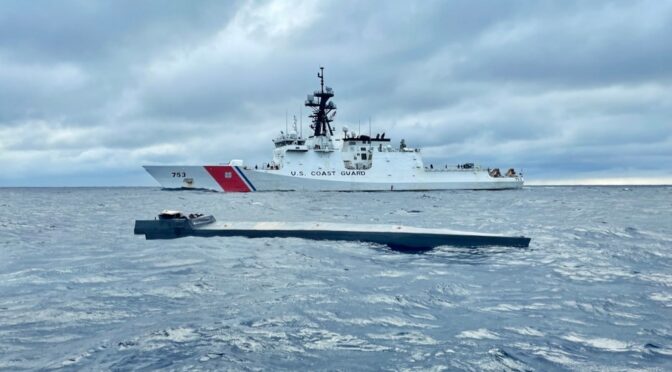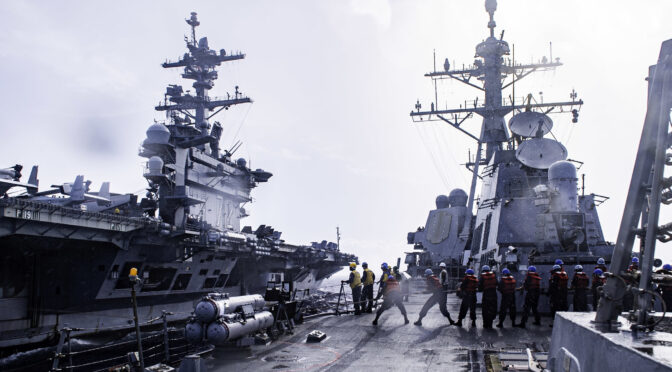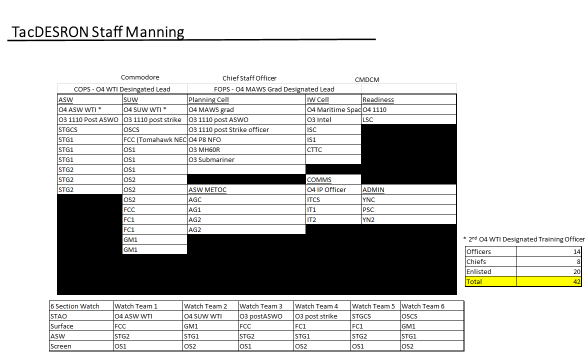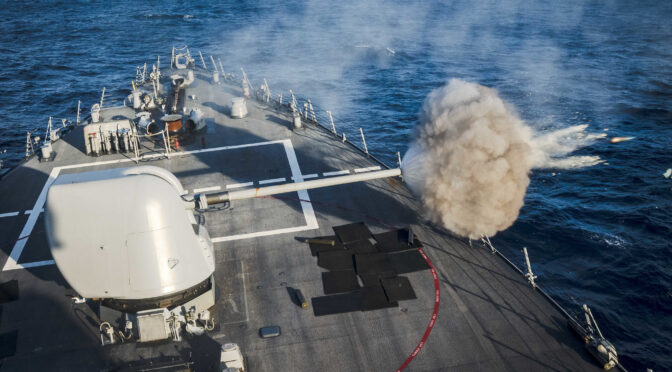By Ben DiDonato
With the return of great power competition, the threat posed by hostile submarines has garnered renewed attention. Russia’s submarine fleet in particular has been regarded as a serious threat for decades and its latest SSNs are reportedly nearly as quiet as their American counterparts. Similarly, while China’s nuclear submarines have yet to reach this level, China’s access to Russian technology, rapid improvements in other areas, and capacity for mass production suggest it is likely to become a serious threat in the relatively near future. Furthermore, while SSNs are obviously the most serious threat due to their range and speed, diesel submarines cannot be overlooked, with many highly lethal designs widely distributed across the globe. In order to compete effectively against near-peer states armed with these submarines, the United States Navy must have the ability to find, track, and sink them.
As in the Cold War, anti-submarine warfare (ASW) is a challenging area of operations, requiring close cooperation between a wide variety of assets to win what would inevitably be a worldwide campaign. This problem was thoroughly studied and, at least in broad strokes, solved by the end of the Cold War, so this strategy provides a useful guide. That review immediately reveals a critical weakness in current American force structure. Submarines and maritime patrol aircraft are still available for independent hunting, surface combatants for close screening, and helicopters for prosecuting targets, but since the retirement of the S-3 Viking, the U.S. Navy has lacked an organic aircraft for initial detection of submarines approaching the aircraft carrier.
The current stopgap solution is pressing the land-based P-8 Poseidon into this role, but that is far from ideal. Tying P-8s to carriers largely squanders their capabilities, preventing the limited supply of these aircraft from doing their real job of patrolling broad stretches of ocean and protecting other ships. Furthermore, relying on land-based support imposes serious constraints on the carrier strike group, which must operate within range of the P-8 and would almost certainly suffer from periods of vulnerability.
This means the current lack of fixed-wing carrier-based ASW capability should be addressed to provide the required coverage without distracting the P-8 force. While there has been some discussion of reactivating the S-3 Viking to restore this capability, that can only ever be a stopgap measure due to the age of the airframes. A long-term solution is needed to restore fixed-wing ASW capability, and fiscal reality demands this solution be flexible and affordable. Rather than build a new dedicated ASW aircraft, it may be better to instead develop a series of ASW pods and a more flexible aircraft suitable for both ground attack and ASW since either type of store can be carried on the pylons with equal ease.
Podded ASW Systems
A minimum of four specialized systems are required to support fixed-wing ASW: a Magnetic Anomaly Detector (MAD), a sonobuoy dispenser, a sonobuoy receiver, and an air-droppable lightweight torpedo. The Mk 54 torpedo already meets the offensive needs on other aircraft, so it should not require substantial modification to fill this role. Similarly, a sonobuoy dispenser is such a simple system that it does not require explanation beyond pointing out that it would ideally come in a variety of sizes for different aircraft/pylons and have variants which incorporate a sonobuoy receiver to minimize pylon consumption.
Therefore, the only system which requires major development is the MAD pod. To enable normal aircraft operation, particularly safe takeoff and landing, this pod would almost certainly need to use a towed MAD rather than the more common boom-mounted system. This would allow the sensor to be trailed a sufficient distance behind the aircraft when needed and retracted when not in use.
Of course, this podded approach is also ideally suited to incorporating future systems as they become available. A wide variety of unmanned systems and new weapons are in development or have been proposed, and all of them could easily be integrated as additional pods. Whether new payloads for sonobuoy dispensers, a single large UAV/UUV on a pylon, some new cluster system, or a novel idea not yet conceived, stuffing it in a pod and hanging it from an existing aircraft will always be faster and cheaper than trying to cram it into an existing airframe, assuming that is even possible. Therefore, while this approach provides an easy path for incorporating future technologies, the four proven systems discussed above can be immediately developed into an effective ASW capability and should be the short-term priority.
In order to provide an affordable near-term capability and maximize long-term utility, both the MAD and sonobuoy pods should be compatible with the new MQ-25 Stingray UAV. In conjunction with the current MH-60R, this would provide a limited standoff detection, prosecution, and engagement capability to the carrier which could be further supplemented by F/A-18s carrying torpedoes, MAD pods, and additional sonobuoys to engage submarines if needed. While this combination is certainly suboptimal, especially considering the problems caused by using F/A-18s as tankers, the MQ-25 would truly come into its own as an ASW platform once the new fixed-wing aircraft proposed below enters service and can use it as a loyal wingman to greatly improve coverage or direct MQ-25 wolfpacks to aggressively prosecute contacts.
A Pod-Carrying Aircraft
Unfortunately, this pod-based approach to ASW is fundamentally incompatible with the S-3 airframe. It cannot carry the number and variety of pods or ground attack weapons required on its two underwing hardpoints, especially when we consider future podded systems. Although its weapons bays contain another four hardpoints, their internal placement would likely interfere with the operation of most pods. Remediating this deficiency by adding new pylons in a major refit is likely impractical due to interference from the under-wing engines. The integrated nature of the S-3’s ASW systems also prevents it from using much of its payload capacity for non-ASW missions. It is simply not possible to replace these fixed systems with ground attack or anti-ship weapons when using the aircraft in other roles, leaving it limited to only six weapons hardpoints for these missions.
Shifting to the budgetary side, integrated systems are generally more expensive to maintain and upgrade than podded systems. Furthermore, the Navy presumably lacks the resources to operate both integrated and podded systems, likely costing the carrier air wing the flexibility to task non-ASW aircraft with ASW missions. Budgetary pressures also make this alternate role critical because the S-3 probably would have survived the global war on terror if it doubled as a low-cost ground attack platform. Therefore, long-term use of the S-3 would be costly and inflexible, so a new solution is needed.
The obvious solution is a completely new aircraft. While this is certainly an option and would presumably produce an excellent aircraft with plenty of capacity, numerous pylons, and a low operating cost, there are two major problems with it. The first is that going through the full development and adoption cycle would take a very long time, likely more than could realistically be covered by a stopgap S-3 reactivation. The second is that major projects like this are politically challenging, with a serious risk of cancelation – assuming they get started at all. While it may be possible to overcome these issues, they are serious enough to merit an examination of alternative options.
The most obvious alternative is to adapt an existing carrier aircraft to take on the role. Within the current carrier air wing, there are two possible airframes, the E-2/C-2, and the V-22.
The E-2/C-2 would obviously make an excellent mono-mission platform since it is already configured to carry a large support crew. However, that same large crew would limit its payload and make risking it in other roles like ground attack unappealing. The only other role it could realistically take on is general airborne drone control, but this can already be performed by the E-2 and fighters so there seems to be little value here, especially since these aircraft can also relay drone datalinks to surface ships. While none of this detracts from an E-2/C-2 derivative’s ability to take on the mission, it does mean it fails to realize the additional flexibility promised by this podded approach, so a different platform is preferable.
The V-22, or more accurately the CMV-22B, may be a better candidate. The ability to transition to helicopter mode would be useful for prosecuting targets, and its unsuitability to ground attack is less of an issue since it is already a cargo aircraft, although the flipside of that is that is that there is less leeway to retask between these two missions than between ASW and ground attack. Unfortunately, payload integration may be an issue, both due to questions about retrofitting pylons on the rotating wing assembly and its more limited digital backbone, and overall external stores capacity would likely be limited after the necessary upgrades based on published payload and range figures. Therefore, while it is certainly worth performing a more detailed study to better understand the true costs, capabilities, and limitations of an ASW V-22 variant, it also seems suboptimal for this pod-based approach.
The final alternative is adapting a land-based aircraft for naval service. While there have certainly been serious problems adapting aircraft in the past, there have also been notable successes like the YF-17’s evolution into the F/A-18 family and the SH-60 family’s decent from the Army’s UH-60. Furthermore, the C-130 famously proved able to operate from the USS Forrestal without modification, and based on a recent interview with the pilot, the flying seems to have been fairly straightforward. While the C-130 itself is obviously too big for regular deck handling, this success strongly implies any aircraft designed to operate from short/rough airfields would be an excellent candidate for marinization, especially with a Super Hornet-style redesign.
There are too many aircraft to go through individually, but desired capabilities narrow the field to a smaller slate. The ideal aircraft would be small enough to operate from a carrier, have short/rough field capability, good payload, plenty of pylons, good fuel efficiency, low maintenance requirements, and excellent handling at low speed and altitude. While most aircraft cannot meet this challenging set of desires, there is one candidate suitable for adaptation into a pod-based multirole ASW aircraft. Not only does this aircraft meet all these desires, but it also has an exceptional ground attack record, proven flexibility in other roles like counter-Fast Attack Craft/Fast Inshore Attack Craft (counter-FAC/FIAC) and combat search and rescue support, and, most importantly, very strong political support to carry the program through budget battles. This aircraft is, of course, the A-10.
The SA-10D Seahog
With an A-10 variant identified as the best option for carrying ASW pods, considering both capability and timeline, we now turn our attention to a brief discussion of what that would look like. The most likely approach is a redesign comparable to the Hornet’s “upgrade” to the Super Hornet because that allows any necessary changes to be incorporated relatively easily. That said, the A-10’s unusually simple airframe may allow boneyard aircraft to be modified for service, even if only as prototypes or a wartime contingency, so that possibility will be discussed here as well. Of course, the program office is not obligated to pick just one option. They could develop both a modification package and a new-build design to improve the competition and provide maximum value to the taxpayer.
Since this aircraft will be largely optimized for affordably hauling underwing stores as a byproduct of this pod-based approach to ASW, that payload can be used in a variety of other roles beyond the obvious close air support. This could entail utility duties like backup tanking, combat support roles like standoff missile carrier, and majority Air Force missions like laying Quickstrike sea mines to further support the rest of the air wing, increase the carrier’s flexibility, and improve the lethality of the joint force.
One other intriguing advantage of using the A-10 as a baseline for the ASW pod carrier is that its short/rough field performance suggests it may be possible to fly it from smaller, simpler ships like amphibs, especially if thrust reversers are added. This would give the joint force the ability to rapidly build new ASW hunter-killer groups if needed and could give the Marines an alternate air support option for amphibious operations if desired. Similarly, this would allow commercial ships to be converted into useful escort carriers in wartime, freeing purpose-built carriers for frontline duties. Finally, this would open up the ability to fly from smaller dedicated aircraft carriers and, while it seems unlikely the United States would build any, a number of its allies operate CVLs and may be interested in acquiring these SA-10Ds to provide organic ASW capability and additional strike capacity to their own carriers.
From a programmatic standpoint, using a few minimally modified A-10A’s from the boneyard could serve to reduce risk and accelerate introduction by entering flight testing prior to delivery of the first full prototype, although this is obviously not required. Most usefully, up to three aircraft could be modified to add a second seat for the ASW systems operator and at least simulated electronics to demonstrate operational effectiveness and begin developing tactics and procedures for the fleet ahead of delivery. The other, less important, conversion would validate performance and carrier suitability by adding a new launch bar and a strengthened arresting hook to a single aircraft.
Naturally, the subject of airframe modification entices interest, so we will now move into a brief exploration of the most interesting changes and options, although basics like more modern engines will be omitted. That said, it is critical to bear in mind that this SA-10D concept is fully dependent on the previously discussed podded systems for ASW operations, so those systems are more important than anything discussed here even though this section will likely generate more discussion.
First and most importantly, the aircraft must have a second seat like the old YA-10B prototype. Modern computers should allow a single person to manage all the ASW equipment instead of the multiple operators required on the S-3, as well as direct any supporting drones, but there is no way the pilot would be able to handle that workload on top of flying the aircraft. It should also be noted that this second crewmember can be swapped for another specialist such as a forward air controller when required for the mission at hand, further improving the air wing’s flexibility. Therefore, whether this is a conversion of old airframes or a new build, a single seat is simply unworkable for the mission.
Closely related to this is electronics. To reduce development costs and streamline maintenance, it is strongly recommended that the F-35’s electronics be reused as close to wholesale as possible. The A-10’s simple airframe should make it relatively easy to integrate these systems, especially if it is a new-build variant, and the commonality would bring new capability and simplify future upgrades. Beyond providing a digital backbone to host the ASW systems, this would make the SA-10D a potent networked shooter by hauling large numbers of long-range missiles and seamlessly communicating with F-35Cs further forwards. This could be further exploited by a new-build aircraft which would likely be larger to further increase capacity and could add dedicated AIM-9X sidewinder rails to provide defensive fire against hostile aircraft.
Folding wings would not ordinarily merit separate discussion because it is obvious a new-build aircraft would include them and that the A-10’s straight wings will allow a dramatic width reduction, but the modification of existing airframes is unusual enough to merit special attention. Unlike most aircraft, the A-10 only carries fuel in its inner wing and is designed with very simple, robust structures with extensive left/right interchangeability. This means the A-10 is in the unusual situation of being able to easily accept folding wings in an upgrade, so modified boneyard aircraft are a feasible option even though they were never intended to operate from carriers.
Of course, any time the A-10 comes up, its gun is a major discussion point so it must be addressed here even if it is not relevant to ASW. Unfortunately, while the GAU-8 has given excellent service, it would almost certainly have to be abandoned for marinization in favor of the F-35’s 25mm GAU-22. While the resulting commonality would streamline shipboard logistics, this change is primarily driven by the fact that the GAU-8’s mounting forces the nose wheel off-center on the A-10, which is unacceptable for catapult launch and results in asymmetric turning circles which may complicate deck handling. One potential upside to this change is that it allows an increase in total stowed ammunition and possibly even the installation of a second gun if desired. This could extend the effective range of the weapon by firing enough explosive rounds to effectively saturate the larger dispersion area, potentially allowing the gun(s) to be effective in the counter-FAC/FIAC role from beyond the range of any man-portable air defense systems they may carry.
The A-10’s armor is similarly a regular point of discussion, although in this case there is no clear answer to be had. If old -A models were to be modified for this new role, it would likely prove more practical to simply leave the armor in place even if it is not particularly useful for the aircraft’s new role since it is integrated into the load-bearing structure. Of course, a new build would not face this restriction, so the armor would almost certainly be omitted to save weight. However, modern materials could allow some level of protection to be retained without much of a weight penalty if desired. Ultimately, the details would have to be worked out between the contractors and the program office, so a definitive answer cannot be given here.
One final exotic option for a new-build aircraft is to integrate a laser weapon to shoot down incoming missiles, or at least provide room for one to be added in the future. The technical risks and costs of this are obvious, but with laser weapons entering service and rapidly maturing, it should at least be considered.
Conclusion
As has been shown, the critical vulnerability left by the retirement of the S-3 can be rapidly and affordably filled to ensure the carrier’s survivability against submarines, and by extension its relevance in great power competition or war. A series of podded sensors would allow the MQ-25 and current aircraft to provide some ASW capacity, while a new SA-10D Seahog can be rapidly developed to fully fill the ASW gap using those podded systems and improve the flexibility of the carrier air wing.
Ben DiDonato is a volunteer member of the NRP-funded LMACC team lead by Dr. Shelley Gallup. He originally created what would become the armament for LMACC’s baseline Shrike variant in collaboration with the Naval Postgraduate School in a prior role as a contract engineer for Lockheed Martin Missiles and Fire Control. He has provided systems and mechanical engineering support to organizations across the defense industry from the U.S. Army Communications-Electronics Research, Development and Engineering Center (CERDEC) to Spirit Aerosystems, working on projects for all branches of the armed forces.
Featured Image: An air-to-air front view of three S-3A Viking aircraft from Air Anti-submarine Squadron 31 (VS-31) as they pass over the USS DWIGHT D. EISENHOWER (CVN-69) (Photo by PH3 Houser, via U.S. National Archives)






